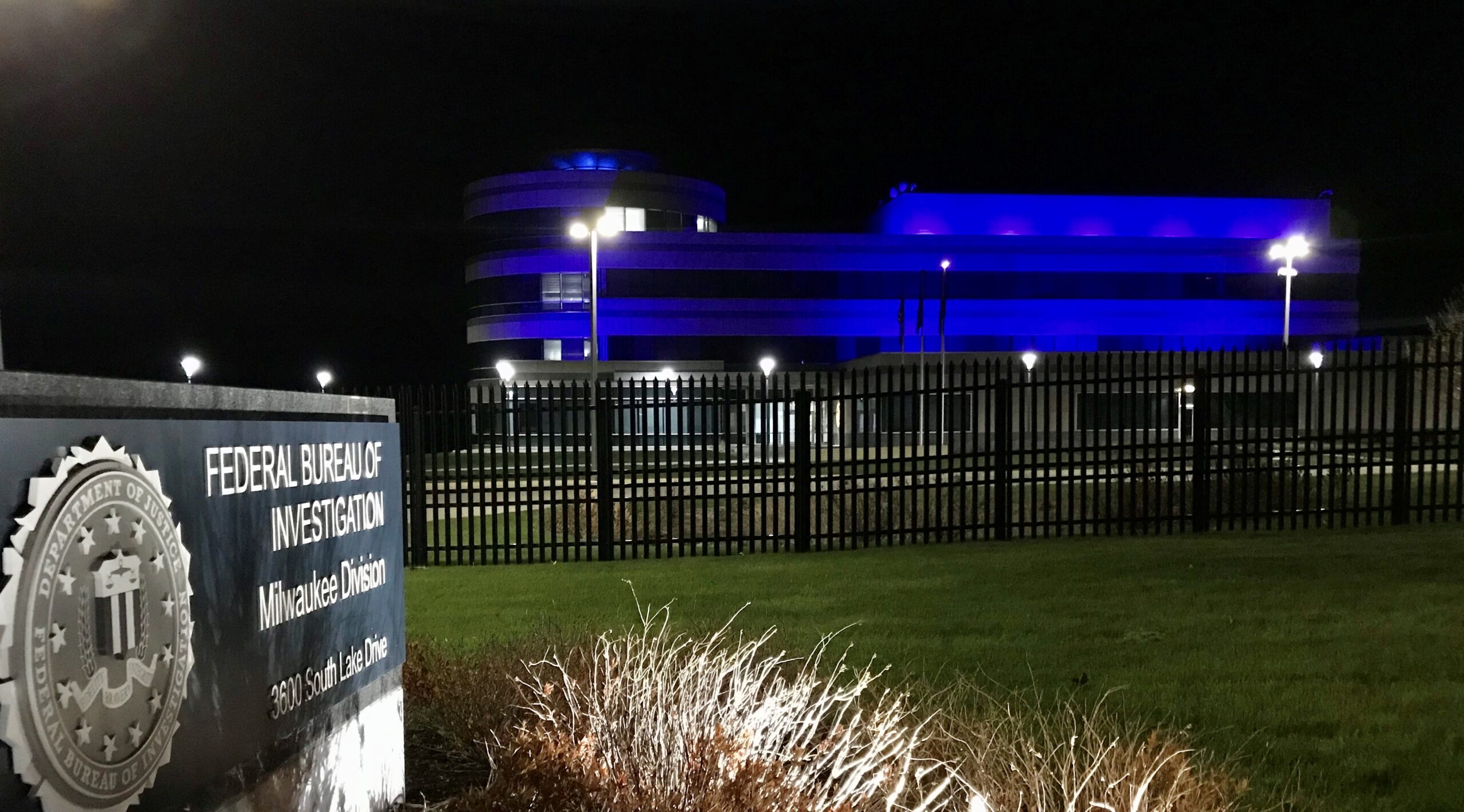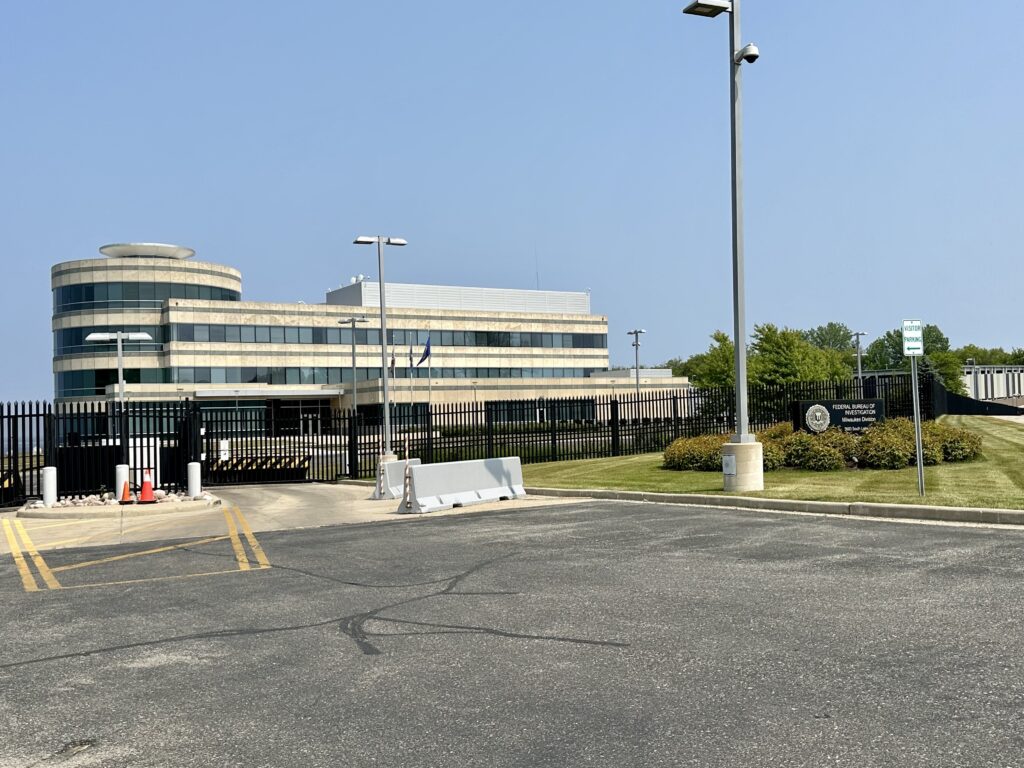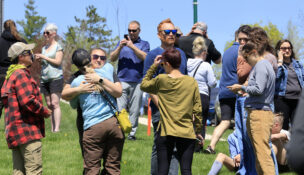Inside the FBI Milwaukee Division
By: Steve Schuster, [email protected]//June 13, 2023//
Published June 13, 2023 at 8:33 a.m. CDT /// Story last updated 4:34 p.m. CDT on June 13, 2023.

Editors Note: Our Managing Editor, Steve Schuster spoke to FBI officials including an Assistant Special Agent in Charge, an FBI analyst, and a public information officer.
By Steve Schuster
[email protected]
A lot has changed in the Badger State and throughout the world in the past seven years since the FBI Milwaukee Division hosted a ribbon cutting ceremony at its new state-of-the-art secured Milwaukee Field Office in June 2016.
Mission priorities of the Field Office have also changed dramatically over the last few decades.
In the 1980s, the FBI Milwaukee Division was keenly focused on combating organized crime, investigating the Milwaukee Mafia and just years later Jeffrey Dahmer. Not too long after that, terrorism became a very acute concern for the United States with the attacks on Sept. 11, 2001.
Since the 9/11 attacks, the Milwaukee Division has played a significant role in terrorism-related investigations while still investigating and making traditional crimes such as: public corruption, cyber, violent crimes, and health care fraud.
When asked by the Wisconsin Law Journal why there are so many public corruption and health care fraud news headlines out of Illinois, but not as many in Wisconsin, FBI Assistant Special Agent in Charge (ASAC) Robert Botsch said health care fraud prosecutions often depend on how “proactive” a local District Attorney or U.S. Attorney’s office is in that area. However, in Wisconsin, there are health care fraud and public corruption cases going on all of the time, he said, noting that they are more time-consuming cases to investigate.
“Anytime you get into financial crimes, it’s going to take a while,” ASAC Botsch said.
Milwaukee County District Attorney John Chisholm told the Wisconsin Law Journal on Tuesday that while he agrees with ASAC Botsch, it also depends “on how proactive the local law enforcement agencies are and what priorities our federal partners set.”
According to Chisholm, while the Milwaukee County District Attorney’s office does work with these types of cases, other agencies have more time and resources for “complex paper cases.”
Chisholm worked with E. Michael McCann back in the mid-1990’s when McCann prosecuted an Illinois based medical lab for negligently handling cervical cancer tests for women in Milwaukee hospitals.
Suffice it to say, the Milwaukee County District Attorney’s office “has a history of these kind of prosecutions,” Chisholm added.
Matt Westphal an Assistant Milwaukee County District Attorney in Public Integrity Unit told the Wisconsin Law Journal Tuesday that “once you start crossing county lines, the local district attorneys have less jurisdiction. At that point the Wisconsin Attorney General or U.S. attorney’s office would get involved.
According to Westphal, while Milwaukee County actively prosecutes healthcare fraud, violent crimes often remain a priority of the office.
Health care fraud and medical malpractice come with a hefty price tag. The National Health Care Anti-Fraud Association estimates that the financial losses due to health care fraud are in the tens of billions of dollars each year.
In 2018, the Milwaukee Journal Sentinel reported Federal prosecutors in Wisconsin investigated the Medical College of Wisconsin and Froedtert Hospital after a former surgeon’s lawsuit claimed administrators didn’t act against a doctor who raised ethical concerns among his peers, then retaliated against the surgeon for pressing the issue.
The Milwaukee Journal Sentinel also reported a prominent Froedtert neurosurgeon allegedly botched a back surgery, leaving a patient unable to walk, and then lied to cover up the error. A Kenosha man accused the physician of fraud and medical malpractice in a 2018 filed lawsuit.
According to Westphal, if a Wisconsin patient has a compliant about a doctor or hospital committing fraud, the patient would file a complaint with the Wisconsin Department of Health Services. (Click here if you have a complaint.) The Department of Health Service would then forward the complaint to law enforcement who would then get the District Attorney’s office or U.S. Attorney’s office involved.
According to the FBI Milwaukee Division, financial crime investigations take longer “because you’re relying heavily on documents and that requires subpoenas and forensic analysis when it comes to forensic accountants when it comes to people deep diving into emails and data. They are longer cases,” ASAC Botsch said, noting that larger offices like FBI Chicago have more resources and more cases. “You may see it more often than in a smaller office in a smaller city with less visibility,” he added.
The FBI moved its Wisconsin headquarters from a commercial complex in downtown Milwaukee to its new standalone facility located at 3600 S. Lake Drive in St. Francis. Previously, the FBI leased space in the Plaza East office buildings at 330 E. Kilbourn Ave. in downtown Milwaukee.
Back in 2016, then Special Agent in Charge Robert J. Shields welcomed more than 200 guests, including law enforcement, elected officials and community partners during the 2016 official ribbon cutting of the new FBI Milwaukee Division’s offices, which was highlighted by a special visit from then FBI Director James B. Comey.
From the standalone airport style security screening facility at the street, to the walls, doors and windows, the current St. Francis facility offers increased security as well as the next-generation of technology to better collaborate with law enforcement partners, investigating a wide range of crimes to include terrorism, complex cyber intrusions, and violent criminal matters.
With a standalone facility, “we can now control anything that comes through that gate, as well as have a guard service that’s able to do that. In the old building, we didn’t have a guard service, we didn’t have that security. We didn’t have fortifications around that building in able to prevent cars from getting close, there’s a huge stand off between the building and the street ” ASAC Botsch said.

ASAC Botsch noted that in the previous office, FBI agents would walk across the street for dinner at Elsa’s, but since the relocation to St. Francis, there are not many restaurants or shops nearby, so agents often dine inside the building due to the long hours they put in and lack of nearby restaurants.
A kitchen is attached to “the wire tap”/ taskforce room, named in honor of a fallen Wisconsin Department of Justice Division of Criminal Investigation Agent John “Jay” Balchunas.
CBS58 reported back in 2021 a dedication ceremony was held to honor Agent Balchunas.
ASAC Bostch said often local, state, and federal law enforcement will spend 16-20 hours in that room listening to wiretaps, emails, and text messages so it naturally makes sense to have a kitchen and bathroom close by.
Back in 2015, a Las Vegas developer bought the former Stark Investments headquarters building in St. Francis to convert it into what has now become the FBI’s Milwaukee Division office. The city of St. Francis passed tax incentives to help reduce the financial burden the FBI. At the time, The Milwaukee Journal Sentinel reported that the Bureau would not have been able to afford the S. Lake Drive building” if it was not for the tax breaks passed by local government.
“We’re told that FBI Tampa has a water view, but it’s a distant water view. We are by far the closest to the water,” said ASAC Botsch.
“The FBI Director said that we have the best view in the entire FBI because we literally sitting right on the water,” ASAC Botsch said.
“On any given day, you can’t tell if it’s a lake or an ocean. From our standpoint you can’t complain coming to work when you look out the window and you’ve got this view,” he added.
Construction aside, from the FBI’s perspective there were other challenges that the Bureau was successful in navigating during the move.
“For us the hardest part … it was moving 200 employees and 80,000 square feet of (items) from one place to the other, with having decades of FBI files that either needed to be moved or shipped to our records management division. When it came to getting furniture and literally everything that goes along with a traditional move, times it by 200 employees and a lot of stuff,” ASAC Botsch said.
The building’s basement is home to a gun vault for tactical operations, a sally port, interview room for detainees, and a training space for both federal agents and members of the office’s Citizens Academy program.
The foyer between the first and second floor features a secured glass wall overlooking the lake, complete with a lounge area and balcony seating.
The second floor is home to a large classroom that can be reorganized into separate classrooms with a temporary wall, or a command post for law enforcement operations and investigations. Conference rooms allow high command staff to meet and fiber under the floor connects all internet and telephone operations, allowing for a highly customizable workspace.
On the first floor near the main entrance, a small FBI museum hosts the Bureau’s personal collections, a bulletin board with the FBI’s Top 10 Most Wanted fugitives, and a wall of the last 10 years of cases. Outside the employee kitchen is a wall memorializing fallen agents across the U.S., including Special Agent W. Carter Baum, the namesake of the building.
Officials are pleased with the end result.
“Generally speaking, we are 100 times better off than we were downtown when it comes to the space, equipment, and infrastructure,” ASAC Botsch added.
FBI Public Affairs Officer Leonard Peace also noted the St. Francis building allows for additional community outreach efforts, including the FBI Citizens academy.
The previous downtown Milwaukee office only allowed for about 20 people to go through that academy, but the St. Francis building has allowed the Milwaukee Division to effectively doubled the class size to 40 people a year, ASAC Botsch noted.
According to ASAC Botsch, the newer St. Francis office also allows the Milwaukee Division the ability to host other events including media round tables, as well as round tables for the overall community on topics including violent crime. Other events include adopt a school program, and various other activities.
Originally the building had served as a powerplant, said ASAC Botsch.
“I remember when I was a kid this was still a power plant,” ASAC Botsch told The Daily Reporter during an in-person interview June 5.
The nearly 83,000-square-foot, $45 million, four-story building opened at 3600 S. Lake Drive in 2016, according to Molasky Group of Companies.
“When Molasky bought it, they tore the building down into the concrete and basically started over. Literally everything was torn out of this building down to the concreate frame and re-built,” ASAC Botsch said.
The 20-year lease, which began in 2016 for a new single tenant building, is quite a contrast to the FBI Milwaukee Division’s previous home, which shared building space with several other tenants.
The General Services Administration (GSA) told the Wisconsin Law Journal on Tuesday that the lease for the St. Francis building began March 25, 2016, and expires on March 24, 2036.
The St. Francis space has other new advantages, ASAC Botsch said.
“One of the benefits to having an FBI standalone building is that we have the ability to control the entire facility, the grounds and the perimeter. The old building was a multi-tenant structure that had a variety of different people in it. There was a restaurant in the basement and there was underground parking, which from our standpoint after Oklahoma City is never a good idea,” ASAC Botsch added, noting that you can’t regulate incoming vehicles and what they contain.
From an infrastructure perspective, the St. Francis office also offers a wide range of advantages.
“We have way more capabilities in this building than we did in the last one as well as space. When it comes to the ability to have better internet, better computer service, better telephone capability, better everything,” ASAC Bostch said noting that the joint terrorism taskforce and groups that focus on public corruption sit in the new space.
According to ASAC Botsch, the new building also offers more space to house 200 FBI employees as well as other task force officers (from other federal agencies) who may co-locate, and local and state government law enforcement officials who frequently work in collaboration with the FBI, such as the Wisconsin Department of Justice’s Division of Criminal Investigation.
According to ASAC Botsch, when other federal agencies work with the FBI they co-locate the Milwaukee division’s office in a new room specifically designed for collaboration for complex interagency investigations ranging from drugs and gangs to protecting the homeland from terrorist attacks.
“There is a room carved out and dedicated in this building for that,” ASAC Botsch noted.
“The only people that can co-locate here would be task force officers. … They belong to their host agency, but are detailed to the FBI. They are given equal space to our people here and whatever our people have access to they generally have access to,” he said.
ASAC Botsch noted that the St. Francis office has multiple computer labs. One is dedicated to cyber intrusion.
“They are looking for people doing hacking,” he said.
Each room was built specially for an intended purpose.
“We knew that we needed a gang space. We knew we needed a space for counter terrorism. We needed a space for cyber,” ASAC Botsch noted.
The St. Francis office also features a rotunda that is illuminated blue at night.
“It’s almost like a lighthouse that shines blue for law enforcement. We originally did it for police week, and then liked the way it looks and what it symbolized and left it up. It’s been blue for the past several years,” ASAC Botsch said.
The previous Milwaukee Division office downtown came with limitations.
“The other building was very limited in scope. It was built for the 20 years prior to us being in that structure. This (current building) was built in 2016 for our current footprint,” ASAC Botsch added.
The St. Francis building offer a great deal more collaboration space, FBI officials noted.
“We have significantly more taskforce space in order to collaborate and work together with our state and local partners,” Botsch said, noting that the extra space also allows the FBI the ability to offer “enhanced training here in our training room.”
“It gives us the ability to house command posts when we have interagency operations. It also gives us the ability to have some onsite forensic capabilities when it comes to our computers, when it comes to evidence processing … there are a lot of different uses that we can generate for the building,” he added.
The space and autonomy the agents get here makes the new location “hundreds” of times better than the Bureau’s former home, Assistant Special Agent in Charge Robert Botsch told The Daily Reporter. Botsch noted one of the biggest aspects of the building was security.
Previously (before the Kilbourn Avenue office), the FBI Milwaukee Division’s office was located inside the Federal Courthouse on Michigan Street in downtown Milwaukee.
ASAC Botsch grew up in the St. Francis area and started his career in local law enforcement as a police officer in Cudahy. After graduating from the FBI Academy in Quantico, Virginia, he was assigned to FBI offices in Texas and Virginia before coming back to home to Wisconsin in 2009.
ASAC Botsch is also well connected in the southeastern Wisconsin law enforcement community.
“The great part about it is a lot of people that I worked with when I was coming up with as a police officer are now in command level positions within the police department,” he said.
Additionally, ASAC Botsch noted he has several family members who work in local law enforcement.
“It does help substantially just because everything is relationship based. When you have the ability to make telephone calls and there is already pre-established trust, there is nobody that is questioning motives. There is nobody questioning what kind of a person you are … they know you are who you say you are and if you say you’re going to do something, you’re going to do it,” he added.
History of FBI Milwaukee Division
The FBI Milwaukee division first open its doors around 1917, but later closed in 1925 and Wisconsin was reassigned to the Chicago and St. Paul divisions.
On May 10, 1935, the Milwaukee Division was reopened in remodeled space in ten rooms on the 10th floor of the Bankers Building.
In the early 1940s, the FBI Milwaukee division investigated activities by Nazi agents and other wartime enemies in its territory. In September 1942, an investigation by Milwaukee FBI agents resulted in the denaturalization proceedings against Hans Behnke, Midwest secretary of a pro-Nazi group the Milwaukee Volksbund, and a member of the “Friends of the New Germany.”
By December 1942, the FBI Milwaukee Division arrested more than 100 “enemy aliens” in Wisconsin who posed a threat to national security; many were members of the Volksbund at Camp Hindenburg, Wisconsin.
During the 1960s and 1970s, the FBI Milwaukee Division was busy investigating anti-war activities, including the July 26, 1970, bombing at Camp McCoy and less than one month later, on August 24, 1970, a massive explosion rocked Sterling Hall on the campus of the University of Wisconsin–Madison.
In the 1980s, the FBI Milwaukee Division was primarily focused on combating organized crime — investigating the Milwaukee Mafia, including Frank Balistrieri, the leader of the La Cosa Nostra operations in Milwaukee, who was later convicted of skimming over two million dollars from Las Vegas casinos that were secretly owned by the Mafia. More than 19 mob leaders were convicted in the course of these investigations, virtually eliminating the hierarchy of organized crime in Kansas City, Milwaukee, and Chicago. Balistrieri was the MOB boss of Milwaukee from 1961-1993. Balistrieri married Antonina Alioto, daughter of Milwaukee crime family boss John Alioto. One FBI investigation had included wiretapping of the Shorecrest Hotel, owned by Balistrieri’s son, Joseph.
During the 1990s, The FBI Milwaukee Division made international news for a case involving serial killer Jeffrey Dahmer, arrested only after one of his victims escaped. Dahmer subsequently confessed to killing and dismembering 17 men and boys.
German mining equipment manufacturer Harnischfeger Industries built its world headquarters on the shores of Lake Michigan in the 1990s in the same location as the current home to FBI Milwaukee Field Office, according to the Society of Architectural Historians. Kahler Slater designed the first iteration of the office building in 1996 which was then taken over by Stark Investments.
Although the Milwaukee division (covering Dodge, Kenosha, Milwaukee, Ozaukee, Racine, Walworth, Washington, and Waukesha Counties) serves as the headquarters for all FBI operations in Wisconsin, the FBI also has six resident agencies throughout the Badger state.
– Duluth-Superior: Ashland, Bayfield, Burnette, Douglas, and Sawyer counties
– Eau Claire: Barron, Chippewa, Clark, Dunn, Eau Claire, Pierce, Polk, Rusk, St. Croix, and Washburn counties
– Green Bay: Brown, Calumet, Door, Forest, Florence, Fond du Lac, Green Lake, Kewaunee, Langlade, Manitowoc, Marinette, Menominee, Oconto, Outagamie, Shawano, Sheboygan, Waupaca, Waushara, and Winnebago counties
– La Crosse: Buffalo, Crawford, Jackson, La Crosse, Monroe, Pepin, Richland, Trempealeau, and Vernon counties
– Madison: Adams, Columbia, Dane, Grant, Green, Iowa, Jefferson, Juneau, Lafayette, Marquette, Rock, and Sauk counties
– Wausau: Iron, Lincoln, Marathon, Oneida, Price, Portage, Taylor, Vilas, and Wood counties
Always remember, if you see something suspicious, say something.
You can report suspicious activities and crime by contacting the FBI Milwaukee by phone (414) 276-4684 or at tips.fbi.gov.
Ethan Duran also contributed to this report.
Legal News
- Wisconsin lawyers file University of Wisconsin public records request seeking answers to protests
- Wisconsin Supreme Court issues orders amending Supreme Court rules and Wis. Stats.
- EXCLUSIVE: Former Milwaukee ‘big law’ partner attacks news media for bias against Trump
- Former Milwaukee election official fined for obtaining fake absentee ballots
- Contract dispute prevents airing of 15 regional sports networks, impacts Brewers
- Wis. middle school focuses on recovery as authorities investigate shooting
- Gov. Evers seeks applicants for Sheboygan and Green County Sheriffs
- North Carolina man who harbored Nazi memorabilia and attacked Black and Latino men sentenced to 41 months
- Nation grieves with families of officers killed in NC
- Amended complaint filed in federal court against State Bar of Wisconsin seeks punitive damages
- United Healthcare suit against cancer drug distributor time-barred
- Trump’s Wisconsin visit warns of jail time if he violates a trial gag order
WLJ People
- Power 30 Personal Injury Attorneys – Russell Nicolet
- Power 30 Personal Injury Attorneys – Benjamin Nicolet
- Power 30 Personal Injury Attorneys – Dustin T. Woehl
- Power 30 Personal Injury Attorneys – Katherine Metzger
- Power 30 Personal Injury Attorneys – Joseph Ryan
- Power 30 Personal Injury Attorneys – James M. Ryan
- Power 30 Personal Injury Attorneys – Dana Wachs
- Power 30 Personal Injury Attorneys – Mark L. Thomsen
- Power 30 Personal Injury Attorneys – Matthew Lein
- Power 30 Personal Injury Attorneys – Jeffrey A. Pitman
- Power 30 Personal Injury Attorneys – William Pemberton
- Power 30 Personal Injury Attorneys – Howard S. Sicula











